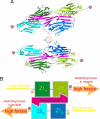The titin-telethonin complex is a directed, superstable molecular bond in the muscle Z-disk
- PMID: 19622741
- PMCID: PMC2726412
- DOI: 10.1073/pnas.0902312106
The titin-telethonin complex is a directed, superstable molecular bond in the muscle Z-disk
Abstract
Mechanical stability of bonds and protein interactions has recently become accessible through single molecule mechanical experiments. So far, mechanical information about molecular bond mechanics has been largely limited to a single direction of force application. However, mechanical force acts as a vector in space and hence mechanical stability should depend on the direction of force application. In skeletal muscle, the giant protein titin is anchored in the Z-disk by telethonin. Much of the structural integrity of the Z-disk hinges upon the titin-telethonin bond. In this paper we show that the complex between the muscle proteins titin and telethonin forms a highly directed molecular bond. It is designed to resist ultra-high forces if they are applied in the direction along which it is loaded under physiological conditions, while it breaks easily along other directions. Highly directed molecular bonds match in an ideal way the requirements of tissues subject to mechanical stress.
Conflict of interest statement
The authors declare no conflict of interest.
Figures



Comment in
-
A new direction for titin pulling.Proc Natl Acad Sci U S A. 2009 Aug 11;106(32):13149-50. doi: 10.1073/pnas.0906989106. Epub 2009 Aug 5. Proc Natl Acad Sci U S A. 2009. PMID: 19666561 Free PMC article. No abstract available.
Similar articles
-
Evidence for a dimeric assembly of two titin/telethonin complexes induced by the telethonin C-terminus.J Struct Biol. 2006 Aug;155(2):239-50. doi: 10.1016/j.jsb.2006.03.028. Epub 2006 Apr 27. J Struct Biol. 2006. PMID: 16713295
-
Mechanical strength of the titin Z1Z2-telethonin complex.Structure. 2006 Mar;14(3):497-509. doi: 10.1016/j.str.2005.12.005. Structure. 2006. PMID: 16531234
-
Palindromic assembly of the giant muscle protein titin in the sarcomeric Z-disk.Nature. 2006 Jan 12;439(7073):229-33. doi: 10.1038/nature04343. Nature. 2006. PMID: 16407954
-
Titin: a molecular control freak.Trends Cell Biol. 1999 Oct;9(10):377-80. doi: 10.1016/s0962-8924(99)01641-4. Trends Cell Biol. 1999. PMID: 10481174 Review.
-
Pulling single molecules of titin by AFM--recent advances and physiological implications.Pflugers Arch. 2008 Apr;456(1):101-15. doi: 10.1007/s00424-007-0389-x. Epub 2007 Dec 6. Pflugers Arch. 2008. PMID: 18058125 Review.
Cited by
-
The giant protein titin: a regulatory node that integrates myocyte signaling pathways.J Biol Chem. 2011 Mar 25;286(12):9905-12. doi: 10.1074/jbc.R110.173260. Epub 2011 Jan 21. J Biol Chem. 2011. PMID: 21257761 Free PMC article. Review.
-
Molecular basis of the mechanical hierarchy in myomesin dimers for sarcomere integrity.Biophys J. 2014 Aug 19;107(4):965-73. doi: 10.1016/j.bpj.2014.06.043. Biophys J. 2014. PMID: 25140432 Free PMC article.
-
CRISPR gene editing in pluripotent stem cells reveals the function of MBNL proteins during human in vitro myogenesis.Hum Mol Genet. 2021 Dec 17;31(1):41-56. doi: 10.1093/hmg/ddab218. Hum Mol Genet. 2021. PMID: 34312665 Free PMC article.
-
Mechanical stability of bivalent transition metal complexes analyzed by single-molecule force spectroscopy.Beilstein J Org Chem. 2015 May 15;11:817-27. doi: 10.3762/bjoc.11.91. eCollection 2015. Beilstein J Org Chem. 2015. PMID: 26124883 Free PMC article.
-
Perturbation-response scanning reveals ligand entry-exit mechanisms of ferric binding protein.PLoS Comput Biol. 2009 Oct;5(10):e1000544. doi: 10.1371/journal.pcbi.1000544. Epub 2009 Oct 23. PLoS Comput Biol. 2009. PMID: 19851447 Free PMC article.
References
-
- Tskhovrebova L, Trinick J. Titin: Properties and family relationships. Nat Rev Mol Cell Biol. 2003;4:679–689. - PubMed
-
- Labeit S, Kolmerer B. Titins: Giant proteins in charge of muscle ultrastructure and elasticity. Science. 1995;270:293–296. - PubMed
-
- Maruyama K. Connectin/titin, giant elastic protein of muscle. FASEB J. 1997;11:341–345. - PubMed
-
- Li H, et al. Reverse engineering of the giant muscle protein titin. Nature. 2002;418:998–1002. - PubMed
-
- Mayans O, et al. Structural basis for activation of the titin kinase domain during myofibrillogenesis. Nature. 1998;395:863–869. - PubMed
Publication types
MeSH terms
Substances
LinkOut - more resources
Full Text Sources
Other Literature Sources
Molecular Biology Databases

